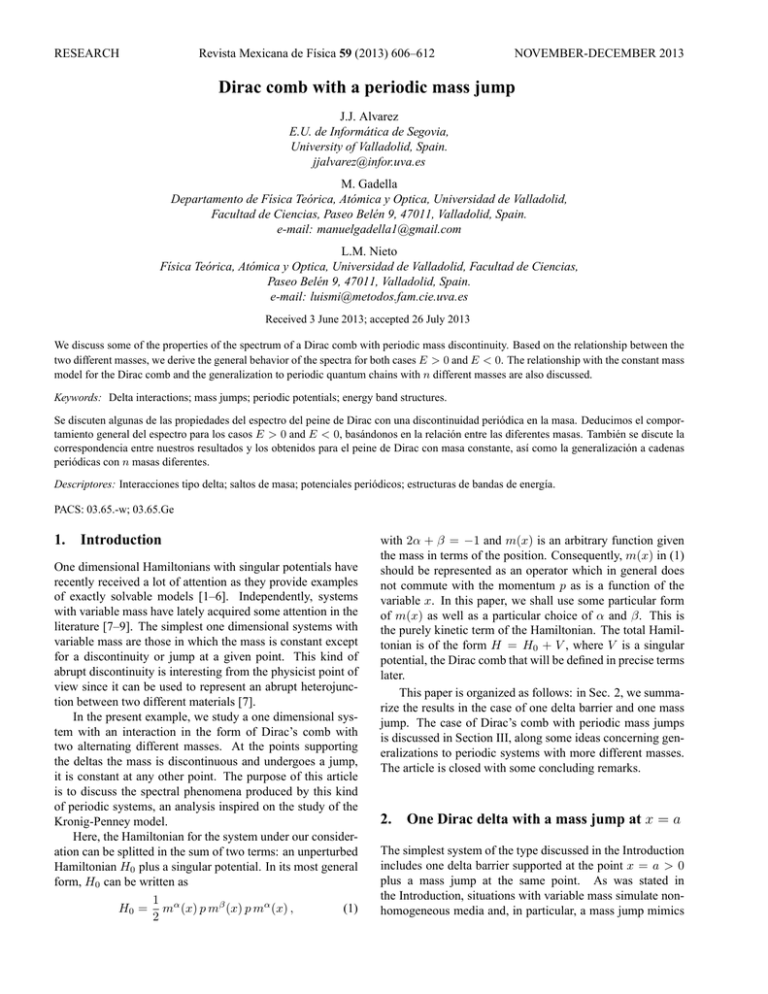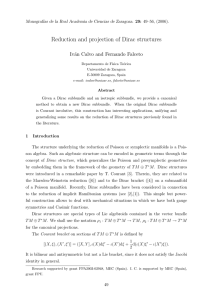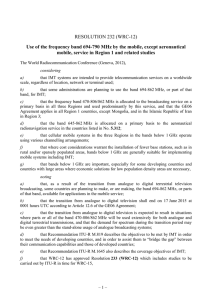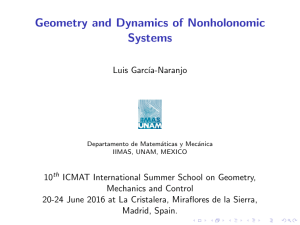Dirac comb with a periodic mass jump
Anuncio

RESEARCH
Revista Mexicana de Fı́sica 59 (2013) 606–612
NOVEMBER-DECEMBER 2013
Dirac comb with a periodic mass jump
J.J. Alvarez
E.U. de Informática de Segovia,
University of Valladolid, Spain.
jjalvarez@infor.uva.es
M. Gadella
Departamento de Fı́sica Teórica, Atómica y Optica, Universidad de Valladolid,
Facultad de Ciencias, Paseo Belén 9, 47011, Valladolid, Spain.
e-mail: manuelgadella1@gmail.com
L.M. Nieto
Fı́sica Teórica, Atómica y Optica, Universidad de Valladolid, Facultad de Ciencias,
Paseo Belén 9, 47011, Valladolid, Spain.
e-mail: luismi@metodos.fam.cie.uva.es
Received 3 June 2013; accepted 26 July 2013
We discuss some of the properties of the spectrum of a Dirac comb with periodic mass discontinuity. Based on the relationship between the
two different masses, we derive the general behavior of the spectra for both cases E > 0 and E < 0. The relationship with the constant mass
model for the Dirac comb and the generalization to periodic quantum chains with n different masses are also discussed.
Keywords: Delta interactions; mass jumps; periodic potentials; energy band structures.
Se discuten algunas de las propiedades del espectro del peine de Dirac con una discontinuidad periódica en la masa. Deducimos el comportamiento general del espectro para los casos E > 0 and E < 0, basándonos en la relación entre las diferentes masas. También se discute la
correspondencia entre nuestros resultados y los obtenidos para el peine de Dirac con masa constante, ası́ como la generalización a cadenas
periódicas con n masas diferentes.
Descriptores: Interacciones tipo delta; saltos de masa; potenciales periódicos; estructuras de bandas de energı́a.
PACS: 03.65.-w; 03.65.Ge
1.
Introduction
One dimensional Hamiltonians with singular potentials have
recently received a lot of attention as they provide examples
of exactly solvable models [1–6]. Independently, systems
with variable mass have lately acquired some attention in the
literature [7–9]. The simplest one dimensional systems with
variable mass are those in which the mass is constant except
for a discontinuity or jump at a given point. This kind of
abrupt discontinuity is interesting from the physicist point of
view since it can be used to represent an abrupt heterojunction between two different materials [7].
In the present example, we study a one dimensional system with an interaction in the form of Dirac’s comb with
two alternating different masses. At the points supporting
the deltas the mass is discontinuous and undergoes a jump,
it is constant at any other point. The purpose of this article
is to discuss the spectral phenomena produced by this kind
of periodic systems, an analysis inspired on the study of the
Kronig-Penney model.
Here, the Hamiltonian for the system under our consideration can be splitted in the sum of two terms: an unperturbed
Hamiltonian H0 plus a singular potential. In its most general
form, H0 can be written as
1
(1)
H0 = mα (x) p mβ (x) p mα (x) ,
2
with 2α + β = −1 and m(x) is an arbitrary function given
the mass in terms of the position. Consequently, m(x) in (1)
should be represented as an operator which in general does
not commute with the momentum p as is a function of the
variable x. In this paper, we shall use some particular form
of m(x) as well as a particular choice of α and β. This is
the purely kinetic term of the Hamiltonian. The total Hamiltonian is of the form H = H0 + V , where V is a singular
potential, the Dirac comb that will be defined in precise terms
later.
This paper is organized as follows: in Sec. 2, we summarize the results in the case of one delta barrier and one mass
jump. The case of Dirac’s comb with periodic mass jumps
is discussed in Section III, along some ideas concerning generalizations to periodic systems with more different masses.
The article is closed with some concluding remarks.
2.
One Dirac delta with a mass jump at x = a
The simplest system of the type discussed in the Introduction
includes one delta barrier supported at the point x = a > 0
plus a mass jump at the same point. As was stated in
the Introduction, situations with variable mass simulate nonhomogeneous media and, in particular, a mass jump mimics
607
DIRAC COMB WITH A PERIODIC MASS JUMP
a sudden change in the media. Here, the idea is to combine
the mass discontinuity with a delta interaction. This system,
which has been already introduced in Ref. 10, is essential
for any further generalization. In addition, its inclusion here
makes the present article self contained. Then, let us first consider the Hamiltonian H0 as in (1) with a mass jump at the
point a > 0. Thus, it seems natural to choose the function of
the mass in terms of the position m(x) to be:
(
m1
if
x<a
m(x) =
.
(2)
m2
if
x>a
We have seen that the kinetic term H0 in (1) depends on
the parameter α (note than if we determine α, β is automatically determined). Among all possible choices, α = 0 and
β = −1 is the most natural and, in addition, it has been
proven to be Galilei invariant [8]. In Ref. 11 we have proven
that a domain of self adjointness for H0 can be provided by
the space of square integrable functions ψ(x) continuous at
x = a and with the following matching conditions for the
first derivative:
1 0
1 0
ψ (a+) −
ψ (a−) = 0 .
m2
m1
(3)
In this case, the kinetic term H0 can be written as [11]:
~2 d 2
,
x < a,
−
2m1 dx2
H0 :=
2
2
− ~ d ,
x > a.
2m2 dx2
a > 0.
Ã
ϕ(a+)
ϕ0 (a+)
!
Ã
ϕ(a−)
=T
!
ϕ0 (a−)
,
(6)
where ϕ(a+) and ϕ(a−) are the boundary values at x = a
of the function ϕ ∈ D(H) to the right and to the left respectively. The 2 × 2 matrix T gives the matching conditions at
x = a and the prime denotes derivative with respect x.
As was proven in a previous article [11], boundary conditions given by T define a domain for which H is self adjoint
if and only if [14]
M1 = T † M2 T ,
(7)
where,
~2
Mi :=
2mi
µ
0 1
−1 0
¶
,
i = 1, 2
(8)
The matching conditions that determine the Hamiltonian
H in (5) are [11]
ψ(a−) = ψ(a+) = ψ(a) ,
1 0
1 0
2λ
ψ (a+) −
ψ (a−) = 2 ψ(a) ,
m2
m1
~
(4)
A thoroughly discussion of the self adjoint versions of (4)
is given in Ref. 12. Another possibility is introduced in
Ref. 10. Also, a discussion on the self adjointness of H0
with mass jump and arbitrary values of α can be carried out
analogously. However, this is not the relevant discussion in
here, where we have in addition to the mass jump, a Dirac
delta at the same point x = a, so that the total Hamiltonian
becomes
H = H0 + λδ(x − a) ,
the Sobolev space W (R/{0}) [13] and fulfill the following
matching conditions at x = a [11]:
(5)
As done with H0 in Ref. 12, a self adjoint version of (5)
should be constructed using the von Neumann formalism of
self adjoint extensions of symmetric operators with equal deficiency indices [1,2]. We shall present a brief discussion of
this in the next subsection.
2.1. Self adjoint determination of H through matching
conditions
According to the theory of self adjoint extensions of symmetric operators, in order to define the total Hamiltonian given in
(5), we need to specify a domain, D(H) for H. This domain
is a subspace of the space of square integrable functions fulfilling certain conditions plus given matching conditions at
x = a. Thus the functions in the domain of H belong to
(9)
which is a simple generalization of (3). Note that the wave
functions on this domain are continuous. The discontinuity
in the derivative is the minimal generalization of the discontinuity defining the delta potential allowing for a mass jump.
In this particular situation, matrix T as in (6) is given by
1
0
.
(10)
T =
2m2 λ
~2
m2
m1
Thus far the discussion on the construction of the Hamiltonian H in (5).
3.
The Dirac comb with mass jumps
Now, we investigate the Dirac comb with mass jumps at the
points supporting the deltas. As is well known, the one dimensional Dirac comb is a one dimensional Hamiltonian of
the form H = −~2 /(2m) d2 /dx2 + V (x), where V (x) is a
singular potential given by
V (x) =
∞
X
γδ(x − na) .
(11)
n=−∞
If the constant mass in the kinetic term of the Hamiltonian
is replaced by a function of the position m(x), we have to
Rev. Mex. Fis. 59 (2013) 606–612
608
J.J. ALVAREZ, M. GADELLA AND L.M. NIETO
determine this function first. The simplest possible choice is
the following:
...
...
......
m1
if
0<x<a
m2
if
a < x < 2a
m(x) :=
.
(12)
m1
if
2a < x < 3a
m
if
3a < x < 4a
2
...
...
......
Now, the situation is the following: at each point of the
infinite sequence na with n ∈ Z, where Z is the set of the
entire numbers, we have a Dirac delta, either attractive or repulsive, plus a mass jump. The function giving the mass in
terms of the position is the simplest possible compatible with
the existence of a mass jump at each point supporting a delta.
This implies that the only possible values of the mass are just
two: m1 and m2 .
In order to define the Hamiltonian H = H0 + V (x),
we follow the procedure suggested in the previous section.
Then, we shall determine matching conditions at the points
xn = na, n ∈ Z. These matching conditions will be given
by the following relations on the wave functions ψ(x):
!
Ã
!
Ã
ψn+1 (na)
ψn (na)
,
(13)
= Tn (na)
0
ψn+1
(na)
ψn0 (na)
were ψn (x) represents the function ψ(x), solution of the
Schrödinger equation, on the interval [(n−1)a, p
na]. Note that
ψn (x) = An eikn x + Bn e−ikn x , where kn = 2mn E/~2 .
3.1.
Determination of the spectrum
Once we have established the matching conditions for the
above situation (11), we would like to obtain its spectrum.
The band structure of the spectrum of the Dirac comb is well
known [15] and it is depicted in Figs. 1 and 2, where the
energy band structure is given by:
| cos ka +
γ
sin ka |≤ 1 .
k
(14)
Thus far, we have not distinguished between a comb with
repulsive (γ > 0) or attractive (γ < 0) deltas. In the case of
repulsive deltas, the expression (14) can be written as
1
| cos(ka − α) |≤ q
1+
γ2
k2
(15)
with tan α = γ/k.
When all deltas are attractive (γ < 0 and E < 0), there is
only one permitted energy band, which is given by
γ
| cosh ka − sinh ka |≤ 1 .
k
(16)
F IGURE 1. Dirac comb with constant mass and γ = 2. Repulsive
case.
F IGURE 2. Diracs comb with constant mass and γ = 2. Atractive
case.
This infinite chain of deltas with mass jumps described so
far can be represented in terms of a one dimensional Bravais
lattice as follows:
... s
c
s
c
s
c
s. . .
Here the black circles represent the regions with m1 and
the white circles the regions with m2 . Between them, we
draw linking lines representing the matching conditions between two regions. This one dimensional lattice has a periodicity 2a.
If we allocate one black circle at the origin of coordinates
and we apply the Bloch theorem, we obtain three wave functions that are the minimal set of solutions of the Schrödinger
equation that solve the Bravais lattice:
ψI (x) = A1 eikx + B1 e−ikx ,
0≤x≤a
ψII (x) = A2 eiξkx + B2 e−iξkx ,
a ≤ x ≤ 2a
ψIII (x) = (A1 eik(x−2a) + B1 e−ik(x−2a) )eiK2a ,
2a ≤ x ≤ 3a .
This is is shown in Fig. 2.
Rev. Mex. Fis. 59 (2013) 606–612
(17)
609
DIRAC COMB WITH A PERIODIC MASS JUMP
Then, applying the matching conditions given by (9) to this set of solutions we get a homogeneous linear system in the variables
A1 , A2 , B1 , B2 , whose coefficients are given by the following matrix:
eika
e−ika
−e−iξka
−eiξka
−ieika (k−2imγ)
ie−ika (k+2imγ)
−ie−ikξa k
ieikξa k
m
m
mξ
mξ
(18)
,
iK2a
iK2a
−2ikξa
2ikξa
e
e
−e
−e
−eiK2a (−ik+2mγ)
m
where
ξ2 =
m2
,
m1
−eiK2a (ik+2mγ)
m
ξ=
k2
,
k1
ie−2ikξa k
mξ
m = m1
−ie2ikξa k
mξ
k = k1 .
(19)
The constant K appears as a consequence of the Bloch
theorem. In fact, the Bloch theorem states that our wave functions must satisfy the relation ψ(x + 2a) = µ ψ(x), where
|µ| = 1. Then, the relation µ = ei2aK defines K.
In order to obtain a nontrivial solution of the above system (17), the determinant of (18) must be zero. If we impose
this condition and after some algebra, we arrive to the following condition:
cos K2a =
1
(2kξ cos ka(k cos ξka
2k 2 ξ
+ 2mγξ sin ξka) − sin ka(−4kmγξ cos ξka
(20)
F IGURE 4. 3D plot of the energy bands for ξ = 1 to ξ = 3 with
γ = 2. Atractive case.
In (20) the periodicity is expressed in terms of the energy and
all the other parameters. As a consequence, we shall obtain a
band spectrum for both the attractive (γ < 0) and the repulsive (γ > 0) cases.
Our results show that the dependency on ξ is rather complicated as is shown in Figs. 3 and 4.
In the repulsive case (Fig. 3), we can observe that the
band structure including the mass jumps does not differs
much from the band structure that appears in the constant
mass case. See Fig. 1.
In the attractive case with constant mass, Fig. 2, we have
only one band. It is noteworthy to remark that, in the mass
jumps case, the longer is ξ 2 = m2 /m1 , i.e., the bigger is the
ratio between masses, the narrower is the energy band width.
This effect is shown in Figs. 5 and 6, where we depict the
band for the values ξ = 1.5 in Fig. 5 and ξ = 2.5 in Fig. 6.
In both cases, the width is shown by the distance between the
two blue lines measured over the k axis. This can be compared to the energy band width for the equal masses case,
ξ = 1. This latter case has been already studied by Cerveró
and coworkers [16].
F IGURE 3. 3D plot of the energy bands for ξ = 1 to ξ = 3 with
γ = 2. Repulsive case.
F IGURE 5. Energy bands for the attractive case with γ = 2,
ξ = 1.5.
+ (−4m2 γ 2 ξ 2 + k 2 (1 + ξ 2 )) sin ξka)) .
Rev. Mex. Fis. 59 (2013) 606–612
610
J.J. ALVAREZ, M. GADELLA AND L.M. NIETO
F IGURE 6. Energy bands for the attractive case with γ = 2,
ξ = 2.5.
3.2.
Limit cases for ξ
In this section we will study the limits for the “strong coupling” (m1 >> m2 ) and “weak coupling” (m1 ∼ m2 ). Here,
we use a = 1 and m = m1 = 1 for simplicity. In the first
case, the limit of ξ → 0 on the Eq. (20) gives:
1
| cos(k − α) |≤ q
¡
1 + k2 −
¢
2γ 2
k
,
(21)
with tan α = (2γ/k) − (k/2). The behavior of (21) is shown
in Figs. 7 and 8. It is clear that the band width goes to zero
√
if we start at the point km = 2 γ and we take both limits
k → 0 and k → +∞. At this starting point, the equation on
the right term in (21) gets its maximum. We observe a perturbation on the permitted energy band closest to the point km
which doubles this band. This effect depends on the parameter γ. This splitting is periodic in γ and occurs at the values
γn = n2 (π 2 /4), with n ∈ N. This comes from the values of
γ that minimize condition (21).
In the weak coupling case (m1 ∼ m2 ):
¯µ
³ ´2 ¶
³ γ ´2 ¯¯
¯
2γ
¯ 1− γ
¯ ≤ 1 (22)
cos
2k
+
sin
2k
+
¯
k
k
k ¯
F IGURE 7. Energy bands for the repulsive case and the strong cou2
pling limit, γn=1 = π4 .
F IGURE 8. Energy bands for the repulsive case and the strong cou2
pling limit, γn=3 = 9π4 .
we observe, in the case k À γ, the same band structure as
observed for equal masses, which is shown in Fig. 1.
For low energies, the condition:
γ(γ + 2) ≤ k 2
(23)
is easily derived. In this case, it appears one permitted energy
band only, which gets narrower as γ grows, up to saturate the
inequality (23). This is depicted in Figs. 9 and 10.
F IGURE 9. Energy bands for the repulsive case for the weak coupling. γ = 2.
F IGURE 10. Energy bands for the repulsive case for the weak coupling. γ = 0.01.
Rev. Mex. Fis. 59 (2013) 606–612
DIRAC COMB WITH A PERIODIC MASS JUMP
4. Concluding remarks
We derive the spectrum of a Dirac comb with a jump of mass
located at the points supporting the deltas. We analyze the
simplest problem in which the mass has two values only. In
addition, all the deltas are multiplied by the same coefficient
γ which is either positive or negative. The result is a periodic
potential which can be analyzed with the help of the Bloch
theorem.
We may be tempted to generalize this model with the
introduction on more different masses m3 , m4 , . . . , mn .
However, this generalization does not give us anything new
as it provides the same one dimensional Bravais lattice and is
therefore equivalent to the situation here considered. Moreover, the introduction of more masses has the undesirable effect of complicating the situation unnecessarily. In particular,
if we had n different masses, we would need to deal with an
2n × 2n matrix.
The results obtained depend on the both the sign of γ and
the square of the ratio between the two different masses. If
1. S. Albeverio, F. Gesztesy, R. Hoegh-Krohn, and H. Holden,
Solvable Models in Quantum Mechanics, (Springer, Berlin,
1988).
2. S. Alveberio and P. Kurasov, Singular Perturbations of Differential Operators, (Cambridge U.P., Cambridge, 1999).
3. P. Kurasov, Journal of Mathematical Analysis and Applications
201 (1996) 297-323.
4. P. Seba, Czechoslovak Journal of Physics 26 (1986) 667-673;
F.A.B. Coutinho, Y. Nogami, and J. Fernando Pérez, Journal of Physics A: Mathematical and General, 30 (1997) 39373945; P.L. Christiansen, H.C. Arnbak, A.V. Zolotaryuk, V.N.
Ermakov, and Y.B. Gaididei, Journal of Physics A: Mathematical and General 36 (2003) 7589-7600; F.M. Toyama, and Y.
Nogami, Journal of Physics A: Mathematical and General 40
(2007) F685-F690; S. Albeverio, L. Dabrowski, and P. Kurasov,
Letters in Mathematical Physics 45 (1998) 33.
T. Fülöp, and I. Tsutsui, Physics Letters A 264 (2000) 366374; P. Hejcik and T. Cheon, Physics Letters A 356 (2006)
290-293; C. Fernández, G. Palma, and H. Prado, Journal of
Physics A: Mathematical and General, 38 (2005) 7509-7518;
A.V. Zolotaryuk, Phys. Rev. A 87 (2013) 052121; Y. Golovaty,
Schrödinger operators with (αδ 0 + βδ)-like potentials: norm
resolvent convergence and solvable models, arXiv:1201.2610.
5. L.J. Boya, Rivista del Nuovo Cimento 31 (2008) 75-139.
6. E. Hernández, A. Jáuregui, and A. Mondragón, Journal of
Physics A: Mathematical and General 33 (2000) 4507-4523;
I.E. Antoniou et al., Chaos, Solitons and Fractals 12 (2001)
2719.
7. R.A. Morrow, and K.R. Brownstein, Physical Review B 30,
(1984) 678 -680.
G.T. Einevoll, and P.C. Hemmer, Journal of Physics C 21
(1988) L1193-L1198; J. Thomsen, G.T. Einevoll, and P.C.
Hemmer, Physical Review B 39 (1989) 12783-12788; G.T.
611
γ > 0, the mass jump does not add any new effect and a band
structure appears similar to the usual band structure shown
in the case of constant masses. If γ < 0, i.e., all deltas are
attractive, the band width goes to zero as the ratio between
masses goes to infinite.
It is clear that our model is equivalent to a one dimensional Bravais lattice.
The limiting cases “strong coupling” (m1 À m2 ) and
“weak coupling” (m1 ∼ m2 ) have been studied. Meanwhile
for weak coupling reappears the band structure shown for
equal masses, new interesting effects emerge for strong coupling.
Acknowledgements
We wish to acknowledge partial financial support by the
Spanish Ministry of Science and Innovation through Project
MTM2009-10751, the Junta de Castilla y León, through
Project GR224.
Einevoll, P.C. Hemmer, and J. Thomsen, Physical Review B
42 (1990) 3485-3496; J.R.F. Lima, M. Vieira, C. Furtado, F.
Moraes, and C. Figueiras, J. Math. Phys. 53 (2012) 072101;
L.A. González-Dı́az and S. Dı́az-Solórzano, J. Math. Phys. 54
(2013) 042106.
8. J.M. Lévy-Leblond, Physical Review A 52 (1995) 1845-1849.
9. N. Moiseyev and R. Lefebvre, Physical Review A 64 (2001)
052711; S. Cruz y Cruz, J. Negro, and L.M. Nieto, Physics
Letters A 369, (2007) 400-406; A. Ganguly, and L.M. Nieto,
Journal of Physics A: Mathematical and Theoretical 40, (2007)
7265-7281; A. Ganguly, S. Kuru, J. Negro, and L.M. Nieto,
Physics Letters A 360 (2006) 228-233; A. Ganguly, M.V. Ioffe,
and L.M. Nieto, Journal of Physics A: Mathematical and General 39 (2006) 14659-14680.
10. M. Gadella, F.J.H. Heras, J. Negro, and L.M. Nieto, Journal of
Physics A: Mathematical and Theoretical 42 (2009) 465207.
11. J.J. Álvarez, M. Gadella, F.J.H. Heras, and L.M. Nieto, Physics
Letters A 373 (2009) 4022.
12. M. Gadella, Ş. Kuru, and J. Negro, Physics Letters A 362 (2007)
265-268.
13. These are continuous functions (except for a finite jump at the
origin) from R into C such that: (i) any ϕ(x) ∈ W (R/{0})
admits a first continuous derivative (except at the origin), (ii)
the second derivative exists almost everywhere, and (iii) both
ϕ(x) ∈ W (R/{0})
R ∞and its second derivative are a.e. square
integrable, so that −∞ {|ϕ(x)|2 + |ϕ00 (x)|2 } dx < ∞.
14. Here H is any self adjoint extension of the free Hamiltonian
H0 defined on the space of functions belonging to the Sobolev
space W (R) and such that they vanish on a neighborhood of
x = a. Each matrix T defines a self adjoint extension of H0
and eventually a singular potential, which depends on T .
15. S. Flügge, Practical Quantum Mechanics, (Springer, New
York, 1974).
Rev. Mex. Fis. 59 (2013) 606–612
612
J.J. ALVAREZ, M. GADELLA AND L.M. NIETO
16. J.M. Cerveró, and A. Rodrı́guez,European Journal of Physics B
30 (2002) 503-510; J.M. Cerveró, and A. Rodrı́guez, European
Journal of Physics B, 32 (2003) 537-543; J.M. Cerveró, and A.
Rodrı́guez, European Journal of Physics B 43 (2005) 543-548.
Rev. Mex. Fis. 59 (2013) 606–612








